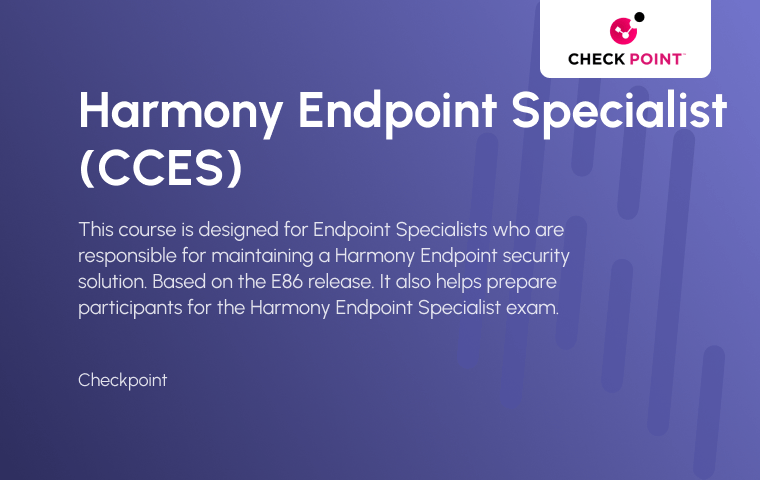
Harmony Endpoint Specialist (CCES)
This course is designed for Security Administrators responsible for deploying and managing a Harmony Endpoint security solution.
Demonstrate an understanding of the Check Point Harmony Endpoint solution, including its features and capabilities. Apply knowledge and skills gained during training to manage and protect a Harmony Endpoint solution.
Apply knowledge of Harmony Endpoint security features and capabilities to protect against imminent threats to the endpoint.
Evaluate and customize security rules and policies to meet an organization’s security needs.
Virtual Classroom Live
Prerequisites
Working knowledge of Unix-like and/or Windows operating systems, networking fundamentals, networking security, TCP/IP networking, administration.
Target Audience
What You’ll Learn
Course Outline
• Describe Check Point Infinity’s Consolidated Security Architecture.
• Explain the difference between the Harmony Endpoint On-Premises
and Cloud management environments.
• Identify the main components of the Harmony Endpoint Security
Architecture.
• Identity the basic workflow for Harmony Endpoint Security
Management.
• Give examples of useful resources for Harmony Endpoint Security
Management.
• Log in to the Web Management Console.
• Navigate the Web Management interface to gain a basic
understanding of the features and capabilities Harmony Endpoint
provides for security management.
• Discuss situations where it might be necessary to change default
policy rules.
• Identify recommended releases for a Harmony Endpoint Client
deployment.
• Identify deployment prerequisites.
• Given a deployment scenario, identify deployment methods,
Endpoint Client packages, and the basic workflow.
• Recognize the different types of data security available to deploy.
• Describe how Full Disk Encryption protects and recovers data that
is accessed and stored on Endpoint computers.
• Identify how to secure removable media devices and protect ports.
• Identify remote help and recovery capabilities.
• Discuss the challenges of threat prevention.
• Identify how Harmony Endpoint defends networks against advanced
threats.
• Identify the key components in Harmony Endpoint simplified and
large-scale deployments.
• Identify sizing guidelines for Harmony Endpoint deployments.
• Give examples of how to expand the solution with Super Nodes and
External Policy Servers.
• Identify the additional capabilities that High Availability (HA) and Active
Directory configurations support.
• Identify useful resources for basic troubleshooting.
• Give examples of potential problems or issues that might occur when
using Harmony Endpoint.
• Investigate and troubleshoot basic Harmony Endpoint troubleshooting
scenarios.
• Define Harmony Endpoint Management as a Service.
• Explain the set-up process for Harmony Endpoint Management as a
Service.
• Discuss the workflow when migrating from Endpoint On-Premises to
Endpoint Management as a Service.
